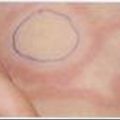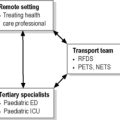6.5 Community-acquired pneumonia
Introduction
Pneumonia is a common condition with significant morbidity and mortality. It is estimated to be responsible for approximately three million childhood deaths per year, most of which occur in developing countries.1 Even in developed countries, pneumonia remains a major cause of acute morbidity and one of the most common reasons for paediatric hospital admissions.2 The incidence of pneumonia is approximately 40 per 1000 children per year in those under five years of age, and 15 per 1000 children per year in 5–14-year-olds.3–5
Aetiology
In the majority of cases of childhood pneumonia, the causative pathogen is not identified. Blood cultures are positive in under 5% of cases of pneumonia.5–7 Transthoracic lung aspiration yields a cause in up to 69% of cases,8,9 but is invasive. It is difficult to obtain adequate sputum for microscopy and culture in young children. Other indirect methods of identifying a cause, such as serology or immunofluorescence and culture of nasopharyngeal aspirates are neither sensitive nor specific.
Although an alveolar or lobar infiltrate on chest X-ray is considered by some to be suggestive of bacterial infection, chest X-ray changes cannot reliably predict aetiology.9,10 Nor is any radiological pattern pathognomonic for viral or Mycoplasma pneumoniae infection.
Age is the best predictor of aetiology of pneumonia. In neonates, where bacterial causes predominate, Group B streptococci and Escherichia coli are the most common pathogens. Viruses, particularly respiratory syncytial virus (RSV), parainfluenza, influenza, metapneumovirus and adenovirus, are the most common cause overall, particularly in young children. The occurrence of recent local outbreaks and the clinical pattern may give a clue to the likely causative virus. These viruses appear to be responsible for approximately 40% of cases of community-acquired pneumonia in children who are hospitalised, particularly in those under 2 years of age, whereas Streptococcus pneumoniae is responsible for 27% to 44% of cases of community-acquired pneumonia.11 Up to 40% of infections are mixed.5 Infection with Mycoplasma pneumoniae and Chlamydia pneumoniae is usually considered to cause pneumonia in children of school age and in older patients, although more recent studies suggest that preschool-aged children have as many episodes of atypical bacterial pneumonia as older children.11 Staphylococcal and Group A streptococcal pneumonia are uncommon, but should be considered in children who are severely unwell with invasive disease. These infections are more likely to be seen in indigenous and Pacific Islander children. More recently, infections with community-acquired multiresistant Staphylococcus aureus (CAMRSA) have emerged. CAMRSA results in a necrotising fulminant pneumonia with increased morbidity and mortality.
Clinical findings
Pneumonia should be considered in any infant or child presenting with fever, cough, difficulty breathing, tachypnoea, increased work of breathing (nasal flaring, lower chest indrawing or recession), and auscultatory findings consistent with consolidation or effusion. However, the auscultatory findings may be unreliable in young children, particularly in those under 1 year. Infants may present with symptoms not obviously related to a lower respiratory tract infection, such as lethargy, vomiting, poor feeding, grunting, or poor perfusion. Children less than 3 months of age may present with apnoea. Tachypnoea is the most sensitive and specific sign12 and may be the only clue in some children. Auscultatory findings, including asymmetrical breath sounds, crackles and bronchial breathing are less predictive. The presence of coryza or wheeze (particularly bilateral) suggests that bacterial pneumonia is unlikely.6,13 Pneumonia located in the apex of the lung may present with neck pain and be confused with meningitis, whilst basal pneumonia may cause abdominal pain, suggestive of an acute abdomen. Conversely, an infant with grunting respirations may give the initial impression of an intra-abdominal problem.
Management
Patients should be stabilised as necessary with high-flow oxygen and fluid resuscitation. Many children will not require any specific treatment. Most children who are not too unwell and have lobar consolidation on chest X-ray can be managed as outpatients with oral amoxicillin 25 mg kg−1 (up to 1 g) three-times daily for 7 days. Children under 1 year of age, and those who are more unwell or hypoxic may require inpatient management (Table 6.5.1) and treatment with intravenous benzylpenicillin 50 mg kg–1 (up to 1.2 g) 6-hourly. Infants less than 3 months of age should also be given intravenous gentamicin 7.5 mg kg–1 daily.
Antibiotic resistance among pneumococci is becoming more common. However, there is no difference in outcome between cases caused by susceptible and resistant strains, and amoxicillin or benzylpenicillin remains the treatment of choice.14,15 The use of third-generation cephalosporins provides no additional benefit over these penicillins. They should be reserved for severe pneumonia where it may be important to cover beta-lactamase producers and Gram-negative bacteria.
A short course (3 days) of antibiotic therapy is as effective as a longer treatment (5 days) for non-severe pneumonia in children under 5 years of age.16
Prevention
The introduction of conjugate H. influenzae type b (Hib) and Strep. pneumoniae vaccines into the routine immunisation schedule in many countries has led to a reduction in the burden of pneumonia caused by these two organisms.17
Conclusion
Pneumonia is a common illness in children. Viruses are the most common cause, and many children will not require any specific treatment. Strep. pneumoniae remains the most common bacterial cause, and amoxicillin remains the antibiotic treatment of choice.18
1 Campbell H. Acute respiratory infection: A global challenge. Arch Dis Child. 1995;73(4):281-283. [Review: 38 refs]
2 Rudan I., Boschi-Pinto C., Biloglav Z., et al. Epidemiology and etiology of childhood pneumonia. Bull World Health Organ. 2008;86(5):408-416.
3 Jokinen C., Heiskanen L., Juvonen H., et al. Incidence of community-acquired pneumonia in the population of four municipalities in eastern Finland. Am J Epidemiol. 1993;137(9):977-988.
4 Murphy T.F., Henderson F.W., Clyde W.A., et al. Pneumonia: An eleven-year study in a paediatric practice. Am J Epidemiol. 1981;113(1):12-21.
5 Juven T., Mertsola J., Waris M., et al. Etiology of community-acquired pneumonia in 254 hospitalized children. Pediatr Infect Dis J. 2000;19(4):293-298.
6 Durbin W.J., Stille C. Pneumonia. Pediatr Rev. 2008;29(5):147-158.
7 Vuori-Holopainen E., Peltola H. Reappraisal of lung tap: Review of an old method for better etiologic diagnosis of childhood pneumonia. Clin Infect Dis. 2001;32(5):715-726.
8 Vuori-Holopainen E., Salo E., Saxen H., et al. Etiological diagnosis of childhood pneumonia by use of transthoracic needle aspiration and modern microbiological methods. Clin Infect Dis. 2002;34(5):583-590.
9 Bettenay F.A., de Campo J.F., McCrossin D.B. Differentiating bacterial from viral pneumonias in children. Pediatr Radiol. 1988;18(6):453-454.
10 Swingler G.H. Radiologic differentiation between bacterial and viral lower respiratory infection in children: A systematic literature review. Clin Pediatr. 2000;39(11):627-633.
11 Ranganathan S.C., Sonnappa S. Pneumonia and other respiratory infections. Pediatr Clin North Am. 2009;56(1):135-156.
12 Palafox M., Guiscafre H., Reyes H., et al. Diagnostic value of tachypnoea in pneumonia defined radiologically. Arch Dis Child. 2000;82(1):41-45.
13 British Thoracic Society. Guidelines for the management of community acquired pneumonia in childhood 2002. Thorax. 2002;57(Suppl. 1):11-24.
14 Friedland I.R. Comparison of the response to antimicrobial therapy of penicillin-resistant and penicillin-susceptible pneumococcal disease. Pediatr Infect Dis J. 1995;14(10):885-890.
15 Tan T.Q., Mason E.O.Jr, Wald E.R., et al. Clinical characteristics of children with complicated pneumonia caused by Streptococcus pneumoniae. Paediatrics. 2002;110(1):1-6.
16 Haider B., Saeed M., Bhutta Z. Short-course versus long-course antibiotic therapy for non-severe community-acquired pneumonia in children aged 2 months to 59 months. Cochrane Database Syst Rev. 16(2), 2008. CD005976
17 Theodoratou E., Johnson S., Jhass A., et al. The effect of Haemophilus influenzae type b and pneumococcal conjugate vaccines on childhood pneumonia incidence, severe morbidity and mortality. Int J Epidemiol. 2010;39(Suppl. 1):i172-185.
18 Kabra S.K., Lodha R., Pandey R.M. Antibiotics for community-acquired pneumonia in children. Cochrane Database Syst Rev. 17(3), 2010. CD004874




